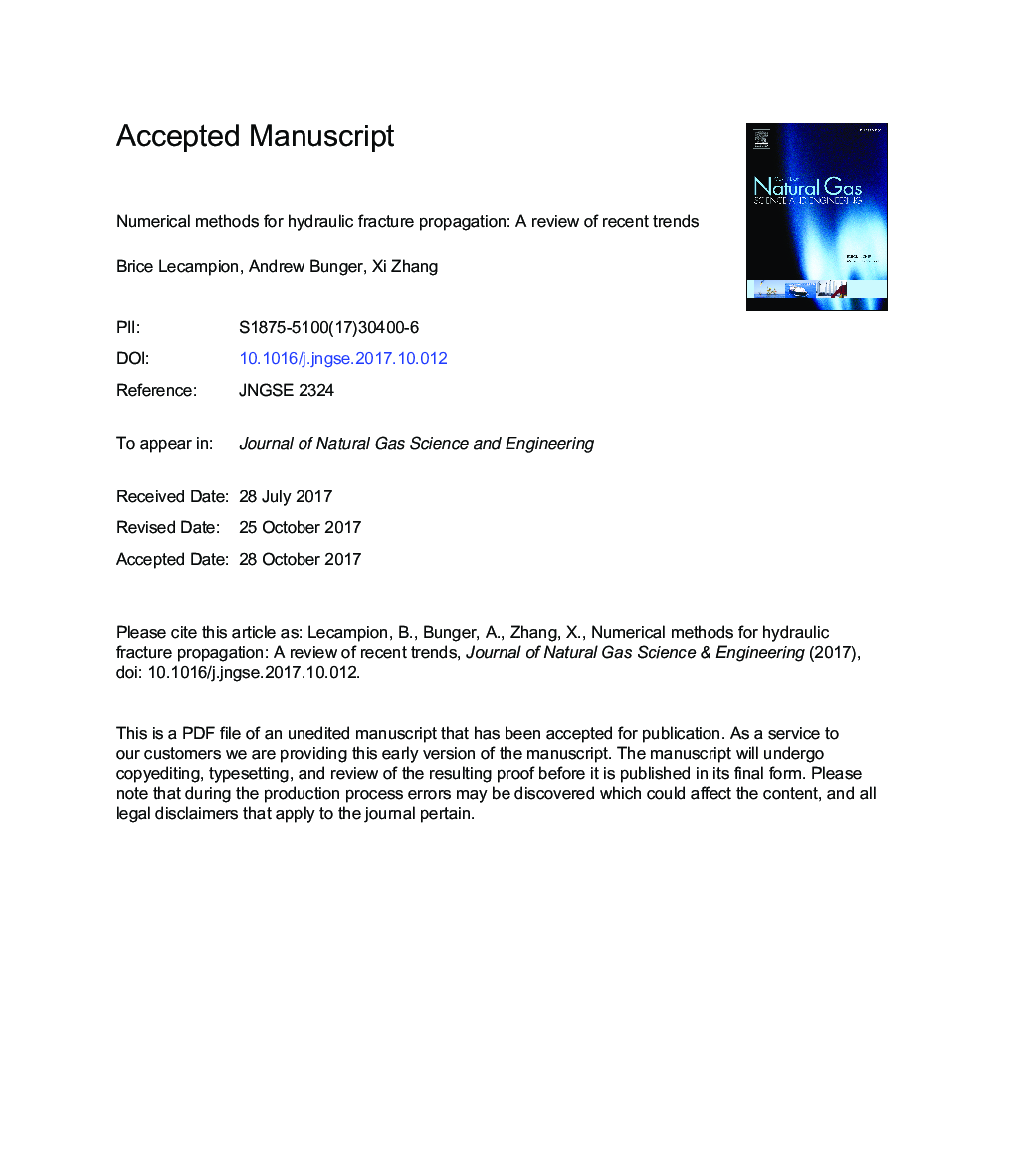| کد مقاله | کد نشریه | سال انتشار | مقاله انگلیسی | نسخه تمام متن |
|---|---|---|---|---|
| 8128434 | 1522994 | 2018 | 86 صفحه PDF | دانلود رایگان |
عنوان انگلیسی مقاله ISI
Numerical methods for hydraulic fracture propagation: A review of recent trends
ترجمه فارسی عنوان
روشهای عددی برای انتشار شکستگی هیدرولیکی: بررسی روند اخیر
دانلود مقاله + سفارش ترجمه
دانلود مقاله ISI انگلیسی
رایگان برای ایرانیان
کلمات کلیدی
تحریک خوب، شکستگی های مایع مدل سازی عددی،
ترجمه چکیده
توسعه روش های عددی برای شبیه سازی شبیه سازی هیدرولیک در دو دهه گذشته تسریع شده است. پیشرفت های اخیر در مدل سازی و شبیه سازی شکست های هیدرولیکی به وسیله افزایش صنعت و فعالیت های تحقیقاتی در زمینه نفت و گاز منجر شده است، در حالیکه به سمت در نظر گرفتن رفتارهای پیچیده تر مرتبط با شکل گیری سنگ های لایه ای و طبیعی شکست خورده، و درک عمیق از مدل ریاضی زیربنایی و آن چالش های ذاتی در اینجا روشهای اساسی مورد استفاده قرار می گیریم. بعضی از این ها شامل پیشرفت روش های کلاسیک هستند، در حالی که دیگران از دیگر زمینه های مکانیک وارد می شوند اما در کاربرد آنها به شکستگی هیدرولیکی کاملا جدید هستند. پس از توصیف چالش های ذاتی مرتبط با مکانیک شکستگی های ناشی از سیال، ما در مورد روش های عددی پیوسته و مزوالکتریکی و همچنین مدل های مهندسی که معمولا از مفروضات اضافی برای کاهش هزینه های محاسباتی استفاده می کنند بحث می کنیم. ما به بررسی و اعتبار مدل های عددی توجه می کنیم، که به طور فزاینده ای توسط کتابخانه ای که از آزمایشات آزمایشگاهی و راه حل های تحلیلی برای هندسه های ساده در تعدادی از رژیم های مختلف پخش استفاده می شود، فعال می شود. تعدادی از چالش ها با در نظر گرفتن مدل سازی شکست هیدرولیکی کاملا سهبعدی و هیدرولیکی هیدرولیکی که به دلیل عدم همبستگی میزبان و سنگ در نظر گرفته شده است، تقویت می شوند. در زمینه چنین رانندگی به مدل های پیچیده، ما استدلال می کنیم که اهمیت توسعه بهتر است که شامل تأیید دقیق و اعتبارسنجی است که برای اطمینان از پیشرفت توسط فیزیک و ریاضیات پایه ای مناسب با توجه ثابت به شرایط شناسایی شده است که تحت آن مدل های ساده تر برای اهداف مدل سازی دلخواه کافی است.
موضوعات مرتبط
مهندسی و علوم پایه
علوم زمین و سیارات
علوم زمین و سیاره ای (عمومی)
چکیده انگلیسی
Development of numerical methods for hydraulic fracture simulation has accelerated in the past two decades. Recent advances in hydraulic fracture modeling and simulation are driven by increased industry and research activity in oil and gas, a drive toward consideration of more complex behaviors associated with layered and naturally-fractured rock formations, and a deepening understanding of the underlying mathematical model and its intrinsic challenges. Here we review the basic approaches being employed. Some of these comprise enhancements of classical methods, while others are imported from other fields of mechanics but are completely new in their application to hydraulic fracturing. After a description of the intrinsic challenges associated with the mechanics of fluid-driven fractures, we discuss both continuum and meso-scales numerical methods as well as engineering models which typically make use of additional assumptions to reduce computational cost. We pay particular attention to the verification and validation of numerical models, which is increasingly enabled by an ever-expanding library of laboratory experiments and analytical solutions for simple geometries in a number of different propagation regimes. A number of challenges remain and are amplified with a drive toward fully-coupled, three-dimensional hydraulic fracture modeling that accounts for host-rock heterogeneity. In the context of such a drive to complex models, we argue that the importance of best-practice development that includes careful verification and validation is vital to ensure progress is constrained by the appropriate underlying physics and mathematics with a constant attention to identifying conditions under which simpler models suffice for the intended modeling purposes.
ناشر
Database: Elsevier - ScienceDirect (ساینس دایرکت)
Journal: Journal of Natural Gas Science and Engineering - Volume 49, January 2018, Pages 66-83
Journal: Journal of Natural Gas Science and Engineering - Volume 49, January 2018, Pages 66-83
نویسندگان
Brice Lecampion, Andrew Bunger, Xi Zhang,
